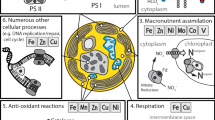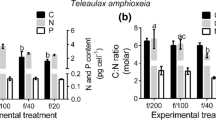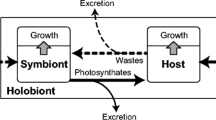Abstract
The effect of ammonium (5, 10 μM N) and phosphate (2, 5, 10 μM P) on the growth of the giant clam Tridacna gigas and its symbiotic dinoflagellate Symbiodinium sp. was examined. A 3 mo exposure to these nutritients significantly increased the N or P composition of the soft tissues, as reflected in a corresponding change in C:N:P ratio. Furthermore, exposure to N or N+P markedly increased the amount of soft tissue, but P alone did not, demonstrating that increased availability of inorganic nitrogen enhances tissue growth of the clam host. With addition of N, or N+P, there was a significant increase in the total number of zooxanthellae per clam, with a corresponding decrease in chlorophyll a (chl a) content per zooxanthella. However, only with N+P was there an increase in the zooxanthellae mitotic index. The inverse relationship between zooxanthellae number and chl a per zooxanthella is consistent with phytoplankton studies indicating conditions of nutrient-limitation. Furthermore, the unaffected C:N:P composition of the zooxanthellae and their relatively low specific-growth rates (4 to 10%) also suggest that they are nutrient-limited in vivo. In particular, their high mean C:N:P ratio of 303:52:1 indicates that, relative to C, they are much more depleted in P and less in N than are free-living phytoplankton. Furthermore, polyphosphates (phosphate reserves) were undetectable, and the activity levels of acid phosphatase in the zooxanthellae were relatively high and not influenced by the host's exposure to increased P concentrations in the sea water, implicating the clam host in active regulation of P availability to its symbiotic algae. This is strong evidence that N-limitation of clam zooxanthellae is a function of the availability of ammonium to the symbiosis while, irrespective of nutrient levels in sea water, clam zooxanthellae still show characteristics of P-limitation.
Similar content being viewed by others
References
Atkinson, M. J., Smith, S. V. (1983). C:N:P ratios of benthic marine plants. Limnol. Oceanogr. 28: 568–574
Belda, C. A., Cuff, C., Yellowlees, D. (1993). Modification of shell formation in the giant clam Tridacna gigas at elevated nutrient levels in sea water. Mar. Biol. 117: 655–664
Bradford, M. M. (1976). A rapid and sensitive method for the quantitation of microgram quantities of protein utilising the principle of protein-dye binding. Analyt. Biochem. 72: 248–254
Cook, C. B., D'Elia, C. F. (1987). Are natural populations of zooxanthellae ever nutrient-limited? Symbiosis 4: 199–212
Cook, C. B., D'Elia, C. F., Muller-Parker, G. (1988). Host feeding and nutrient sufficiency for zooxanthellae in the sea anemone Aiptasia pallida. Mar. Biol. 98: 253–262
D'Elia, C. F., Domotor, S. L., Webb, K. L. (1983). Nutrient uptake kinetics of freshly isolated zooxanthellae. Mar. Biol. 75: 157–167
Domotor, S. L., D'Elia, C. F. (1984). Nutrient uptake kinetics and growth of zooxanthellae maintained in laboratory culture. Mar. Biol. 80: 93–101
Dubinsky, Z., Stambler, N., Ben-Zion, M., McCloskey, L. R., Muscatine, L., Falkowski, P. G. (1990). The effect of nutrient resources on the optical properties and photosynthetic efficiency of Stylophora pistillata. Proc. R. Soc. (Ser. B) 239B: 231–246
Fitt, W. K., Heslinga, G. A., Watson, T. C. (1993a). Utilisation of dissolved inorganic nutrients in growth and mariculture of the tridacnid clam Tridacna derasa. Aquaculture, Amsterdam 108: 109:27–38
Fitt, W. K., Rees, T. A. V., Yellowlees, D. (1993b). Role of haemolymph in the uptake of dissolved inorganic nitrogen to the giant clam — zooxanthellae symbiosis. (In preparation)
Goldman, J. C. (1977). Steady state growth of phytoplankton in continuous culture: comparison of internal and external nutrient equations. J. Phycol. 13: 251–258
Greene, R. M., Geider, R. J., Kolber, Z., Falkowski, P. G. (1992). Iron-induced changes in light harvesting and photochemical energy conversion processes in eukaryotic marine algae. Pl. Physiol. 100: 565–575
Harold, F. M. (1966). Inorganic polyphosphates in biology: structure, metabolism, and function. Bact. Rev. 30: 772–793
Hastie, L., Watson, T. C., Isamu, T., Heslinga, G. A. (1992). Effect of nutrient enrichment of Tridacna derasa seed: dissolved inorganic nitrogen increases growth rate. Aquaculture, Amsterdam 106: 41–49
Heinonen, J. K., Lahti, R. S. (1980). A new and convenient colorimetric determination of inorganic orthophosphate and its application to the assay of inorganic pyrophosphatase. Analyt. Biochem. 113: 313–317
Hoegh-Guldberg, O., Smith, G. J. (1989). Influence of the population density of zooxanthellae and supply of ammonium on the biomass and metabolic characteristics of the reef corals Seriatopora hystrix and Stylophora pistillata. Mar. Ecol. Prog. Ser. 57: 173–186
Jackson, A. (1989). Phosphorus metabolism in Symbiodinium sp. Ph.D. thesis. James Cook University of North Queensland, Townsville
Jackson, A. E., Miller, D. J., Yellowlees, D. (1989). Phosphorus metabolism in the coral-zooxanthellae symbiosis: characterisation and possible roles of two acid phosphatases in the algal symbiont Symbiodinium sp. Proc. R. Soc. (Ser. B) 238: 193–202
Jeffrey, S. W., Humphrey, G. F. (1975). New spectrophotometric equations for determining chlorophylls a, b, c1, and c2 in higher plants, algae, and natural phytoplankton. Biochem. Physiol. Pfl. 167: 191–194
Liddicoat, M. I., Tibbits, S., Butler, E. I. (1975). The determination of ammonia in seawater. Limnol. Oceanogr. 20: 131–132
Miller, D. J., Yellowlees, D. (1989). Inorganic nitrogen uptake by symbiotic marine cnidarians: a critical review. Proc. R. Soc. (Ser. B) 237: 109–125
Muscatine, L., Falkowski, P. G., Dubinsky, Z., Cook, P. A., McCloskey, L. R. (1989). The effect of external nutrient resources on the population dynamics of zooxanthellae in a reef coral. Proc. R. Soc. (Ser. B) 236: 311–324
Muscatine, L., Falkowski, P. G., Porter, J. W., Dubinsky, Z. (1984). Fate of photosynthetic fixed carbon in light- and shade-adapted colonies of the symbiotic coral Stylophora pistillata. Proc. R. Soc. (Ser. B) 222: 181–202
Muscatine, L., Pool, R. R. (1979). Regulation of numbers of intracellular algae. Proc. R. Soc. (Ser. B) 204: 131–139
Muscatine, L., Pool, R. R., Cernichiari, E. (1972). Some factors influencing selective release of soluble organic material by zooxanthellae from reef corals. Mar. Biol. 13: 298–308
Norton, J. H., Shepherd, M. A., Long, H. M., Fitt, W. K. (1992). The zooxanthellal tubular system in the giant clam. Biol. Bull. mar. biol. Lab., Woods Hole 183: 503–506
Patni, N. J., Aaronson, S. (1978). Extracellular acid phosphatase of Ochromonas danica. In: Hellebust, J. A., Craigie, J. S. (eds.) Handbook of phycological methods: physiological and biochemical methods. Cambridge University Press, London, p. 263–266
Porter, J. W., Muscatine, L., Dubinsky, Z., Falkowski, P. G. (1984). Primary production and photoadaptation in light- and shadeadapted colonies of the symbiotic coral Stylophora pistillata. Proc. R. Soc. (Ser. B) 222: 161–180
Raven, J. A. (1984). Energetics and transport in acquatic plants. Alan R. Liss, Inc., New York
Rees, T. A. V. (1991). Are symbiotic algae nutrient deficient? Proc. R. Soc. Lond. (Ser. B) 243: 227–233
Rees, T. A. V., Fitt, W. K., Baillie, B., Yellowlees, D. (1993a). A method for temporal measurement of haemolymph composition in the giant clam symbiosis and its application to glucose and glycerol levels during a diel cycle. Limnol. Oceanogr. 38: 123–127
Rees, T. A. V., Fitt, W. K., Yellowslees, D. (1993b). Host glutamine synthetase activities in the giant clam symbiosis: effect of clam size, elevated ammonium and continuous darkness. (In preparation)
Shapiro, S. S., Francia, R. S. (1972). An approximate analysis of variance test for normality. J. Am. statist. Ass. 67: 215–261
Shapiro, S. S., Wilk, M. B. (1965). An analysis of variance test for normality (complete samples). Biometrika 52: 591–611
Stambler, N., Popper, N., Dubinsky, Z., Stimson, J. (1991). Effects of enrichment and water motion on the coral Pocillopora damicornis. Pacif. Sci. 45: 299–307
Strickland, J. D. H., Parsons, T. R. (1972). A practical handbook of seawater analysis. 2nd ed. Bull. Fish. Res. Bd Can. 167: 1–310
Trench, R. K. (1971). The physiology and biochemistry of zooxanthellae symbiotic with marine coelenterates. III. The effect of homogenates of host tissues on the excretion of photosynthetic products in vitro by zooxanthellae from two marine coelenterates. Proc. R. Soc. (Ser. B) 177: 251–264
Trench, R. K. (1987). Dinoflagellates in non-parasitic symbiosis. In: Taylor, F. J. R. (ed.) The biology of dinoflagellates. Blackwell Scientific Publishers, Oxford, p. 530–570
Trench, R. K., Wethey, D. S., Porter, J. W. (1981). Observations on the symbiosis with zooxanthellae among the Tridacnidae (Mollusca, Bivalvia). Biol. Bull. mar. biol. Lab., Woods Hole 161: 180–198
Underwood, A. J. (1981). Techniques of analysis of variance in experimental marine biology and ecology. Oceanogr. mar. Biol. A. Rev. 19: 513–605
Wilkerson, F. P., Kobayshi, D., Muscatine, L. (1988). Mitotic index and size of symbiotic algae in Caribbean reef corals. Coral Reefs 7: 29–36
Wilkerson, F. P., Parker, G. T., Muscatine, L. (1983). Temporal patterns of cell division in natural populations of endosymbiotic algae. Limnol. Oceanogr. 28: 1009–1014
Winer, B. J. (1971). Statistical principles in experimental design. McGraw-Hill, Tokyo, Japan
Yellowlees, D., Dionisio-Sese, M., Masuda, K., Maruyama, T., Abe, T., Baillie, B., Tsuzuki, M., Miyachi, S. (1993a). Role of carbonic anhydrase in the supply of inorganic carbon to the giant clam—zooxanthellae symbiosis. Mar. Biol. 115: 605–611
Yellowlees, D., Rees, T. A. V., Fitt, W. K. (1993b). The effect of ammonium supplemented sea water on the glutamine synthetase and glutamate dehydrogenase activities in the host tissue and zooxanthellae of Pocillopora damicornis and on the ammonium uptake rates of the zooxanthellae. Pacif. Sci. (in press)
Zar, J. J. (1984). Biostatistical analysis. 2nd ed. Prentice-Hall, Englewood Cliffs, New Jersey
Author information
Authors and Affiliations
Additional information
Communicated by G. F. Humphrey, Sydney
Rights and permissions
About this article
Cite this article
Belda, C.A., Lucas, J.S. & Yellowlees, D. Nutrient limitation in the giant clam-zooxanthellae symbiosis: effects of nutrient supplements on growth of the symbiotic partners. Marine Biology 117, 655–664 (1993). https://doi.org/10.1007/BF00349778
Received:
Accepted:
Issue Date:
DOI: https://doi.org/10.1007/BF00349778




